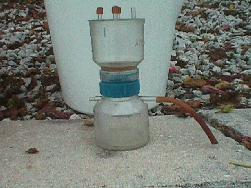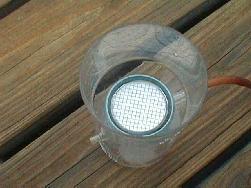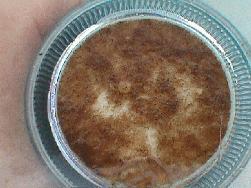
Determining the Numbers of Plankton B
Method II is a more refined way to determine plankton numbers. As with Method A the numbers of plankton in a small sample are determined. The small sample us assumed to be representative of the plankton collected in the net. The equipment used in this experiment must be handled with care.
MATERIALS:
Previously collected plankton samples
Millipore Filtration Apparatus 
H.A. Grid Filters with a 0.454 pore size
300 ml of isotonic saline solution
Forceps
Immersion oil
Petri dish  note the grids on the filter
paper
note the grids on the filter
paper
Monocular microscope or dissecting microscope
1 -1ml pipette
PROCEDURE:
1. Prepare a Millipore Filtration Apparatus using a Type H. A.
Grid filter with a 0.454 pore size.
(A detailed description of the apparatus may
found in the activity: "Analysis of Water for Bacterial Pollution".)
2. Add approximately 100ml of isotonic salt solutions to the top portion of the filtration apparatus.
3. Shake the plankton sample well to insure that the plankton are uniformly distributed and quickly pipette out 1.0. ml.
4. Add the 1.0 ml sample into the filtration apparatus. Rinse the pipette with isotonic salt solution to make certain that all the plankton are transferred into the apparatus.
5. Swirl the salt solution and sample carefully to insure uniform mixing.
6. Using the syringe, suction the water into the lower part of the filtration apparatus or as in the picture, use the tube to suck the water through.
7. Rinse down the sides of the upper half of the filtration apparatus with about 50 ml of salt solution to insure that no plankton adhere to the sides.
8. Again using the syringe, suction the solution through the filter. This will leave the plankton evenly distributed on the filter surface.
9. Open the filtration apparatus and carefully remove the filter using forceps. Place the filter on a towel or blotting paper, plankton side up and dry for about 5 minutes.
10. When dry, take a ballpoint pen and circle the samples as shown below. Be careful to make your circles large enough so they do not come near any line on the square you will count.
11. Float your filter on a thin layer of immersion oil in a clean petri dish. This will render it transparent for microscope use.
12. Transfer the filter to a glass slide for counting the particles on each sample square.
13. Use low power of your microscope. If a part of an organism touches the top or left hand line of the square, count it; if it touches the bottom or right hand line of the square, do NOT count it. Why is this necessary? Tabulate the number of plankton in each square. Record your results on your data sheet.
NOTE: if the plankton are so densely packed you can't count them, go back to step 4 to dilute the sample even more. To dilute by 10%, take a well mixed 10 ml portion of the previously diluted plankton sample you prepared and place in a 100ml graduated cylinder--add saline to the 100 ml mark. If there are too few, go back to step 5 and proceed. Instead of taking a 1.0 ml sample from the plankton take 10 ml (to increase 10x).
14. The number of plankton counted are then multiplied by a number to calculate the count which would have been found had the entire surface of the filter been scanned.
The formula is:
___________ X number of plankton = number of plankton on filter 10 grid squares
15. RECORD this figure as the total number of plankton on the filter.
If 22 plankton were counted on the ten grids,
145/10 x 22 = 319 plankton on filter
16. Knowing the number of plankton on the filter, it is easy to estimate the number of the original sample by multiplying the number on the filter by the Dilution Factor. The dilution factor is determined by dividing the original sample volume by the size of the sub-sampled you pipetted. (either 1 ml or 5 ml).
{ dilution factor = sample volume / pipette volume }
Determine the total number of plankton in the concentrated sample.
{Number on filter x dilution factor = Number of plankton in conc. sample}
17. To calculate the Number of Plankton / M3, simply divide the number of plankton in the sample by the volume of water sampled originally. (Plankton ID's)
FORMULA:
Number of Organisms in Sample = Number of Organisms = Density
volume of sample in M3 M3
Record your density on your data sheet.
Introduction - Volume of Sample - Numbers in Sample 1